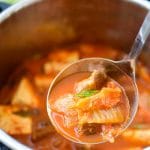This Korean seafood hot pot is hearty, spicy, packed with savory and briny flavors!

It’s been bitterly cold around here over the last few days and snowing again today. Cold winter days call for warm comforting soups or stews. This seafood hot pot (haemul jeongol, 해물전골) is a family favorite! It’s hearty, spicy, packed with savory and briny flavors, bubbling hot, and visually appealing!
I make this dish every time my children come home. I cook it at the table over a portable gas burner which adds fun to the ordinary dinner table. Everyone gathers around the table, patiently watching the hot pot cooking, and then takes his or her own portion in a small bowl directly from the pot.
What is Jeongol?
Jeongol is a type of Korean stew (jjigae, 찌개). The difference between jeongol and jjigae is subtle in some cases, but jeongol tends to be more elaborate. The ingredients are typically arranged nicely in a wide, shallow pot for an eye-catching visual appearance, and the pot is usually cooked at or by the table. This is the way the dish was prepared for wealthy and royal families in the past.
How to make Korean seafood hot pot
Seafood
Haemul jeongol is made with an assortment of seafood. It’s totally versatile so you can use any kind or combination of seafood. I generally use a combination of crabs, shrimp, clams, mussels, squid, octopus, and firm white flesh fish, depending on what I have in the freezer. Occasionally, I also throw in lobsters or scallops as a special treat. Whatever seafood you use, make sure you use lots of it!
Vegetables
The vegetable ingredients in this recipe are what I typically use, but you can modify with ingredients you can easily find or already have in the fridge. Although I use anchovy broth as a soup base for depth of flavor, water will be fine too as all the seafood in the recipe will impart lots of flavor to the broth.
The prepared pot will initially look very full, but the ingredients will cook down significantly. Also, you don’t have to load up all the ingredients at once. You can add more as you cook or take some out to eat. Most ingredients in this recipe don’t take long to cook.
For more Korean cooking inspirations, follow along on YouTube, Pinterest, Twitter, Facebook, and Instagram.

Ingredients
- 8 little neck clams and/or mussels
- 2 blue crabs or Korean kkotge, 꽃게
- 8 ounces squid and/or octopus
- 8 ounces white flesh fish snapper, tilapia, or monkfish
- 8 large shrimp preferably shell-on
- 6 ounces soybean sprouts kongnamul, 콩나물
- 8 ounces napa cabbage inner tender part
- 3 ounces of Korean radish mu, 무
- 1 medium carrot
- 1/2 medium onion
- 3 mushroom caps
- 2 scallions
- 2 ounces of watercress or crown daisy ssukgat, 쑥갓
Seasoning (see note)
- 2 tablespoons gochugaru use more if you like it spicier
- 1 tablespoon soup soy sauce or fish sauce
- 1 teaspoon salt
- ⅛ teaspoon pepper
- 1 teaspoon gochujang
- 1 teaspoon doenjang
- 1 tablespoon minced garlic
- 1 teaspoon grated ginger
Broth
- 3 cups (or 4) anchovy broth or water
- 1 tablespoon fresh lemon juice - optional
Instructions
- Scrub and place the clams in salted water (1 tablespoon of salt in 2 to 3 cups of water) for 30 minutes or longer to get the clams to spit out the sand. Separate the top shell from the crab and remove the gills. Clean the shell part thoroughly, with a kitchen brush or a toothbrush, under running water. Break (or cut) the body in half (or quarters). Clean the squid and fish, and cut into bite size pieces. Clean the shrimp.
- Scatter the seafood pieces on top of vegetables, placing the clams/mussels closer to the bottom of the pan. Add 3 cups of broth and the seasoning paste, reserving 1 tablespoon to add as necessary to your liking. Top it with the watercress (or crown daisy), and cook over medium high heat until the clams/mussels are open, the fish is cooked through and the vegetables are softened. Drizzle the optional lemon juice over. Stir occasionally.
- You can add more broth and any remaining ingredients while eating if you’re cooking at the table.





























